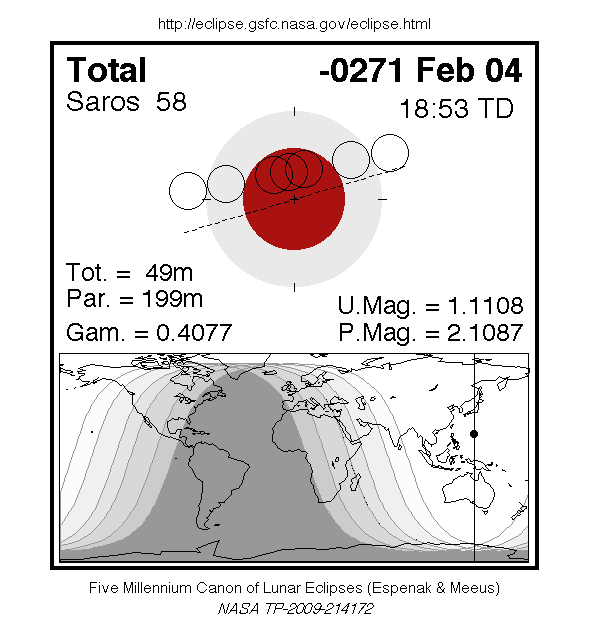A total eclipse of the Moon occurred on 4 February, 0272 BC UT Old Style, with maximum eclipse at 15:05 UT. A shallow total eclipse saw the Moon in relative darkness for 49 minutes and 24 seconds. The Moon was 11% of its diameter into the Earth's umbral shadow, and should have been significantly darkened. The partial eclipse lasted for 3 hours and 19 minutes in total.
The penumbral eclipse lasted for 5 hours and 22 minutes.
The partial eclipse lasted for 3 hours and 19 minutes.
The total eclipse lasted for 49 minutes and 24 seconds.
Maximum eclipse was at 15:05:59 UT.
Overview Map
This map sourced from NASA Goddard Space flight Center: GSFC Eclipse Web SiteGSFC Eclipse Web Site
The primary source of all the information on eclipses presented here at Hermit Eclipse. (NASA Goddard Space flight Center)
shows the visibility of the eclipse. (Click on it for the
full-sized version.)
Eclipse Season and Saros Series
This eclipse season contains 2 eclipses:
This was the 31st eclipse in lunar Saros series 58.The surrounding eclipses in this Saros series are:
This Saros series, lunar Saros series 58,
is linked to solar Saros series 65. The
nearest partner eclipses in that series are:
Eclipse Parameters
| UT Date/time (max) | 15:05:59 on 4 Feb UT |
TDT Date/time (max) | 18:53:04 on 4 Feb TDT |
| Saros Series | 58 |
Number in Series | 31 |
| Penumbral Magnitiude | 2.1087 |
Central Magnitiude | 1.1108 |
| Gamma | 0.4077 |
Path Width (km) | |
| Delta T | 3h47m |
Error | ± 11m25s (95%) |
| Penumbral Duration | 5h22m |
Partial Duration | 3h19m |
| Total Duration | 49m24s |
| |
| Partial Rating | |
Total Rating | |
Note that while all dates and times on this site (except
where noted) are in UT, which is within a second of civil time,
the dates and times shown in NASA's eclipse listingsGSFC Eclipse Web Site
The primary source of all the information on eclipses presented here at Hermit Eclipse. (NASA Goddard Space flight Center)
are in the TDT timescale.
Data last updated: 2015-06-21 22:11:42 UTC.

